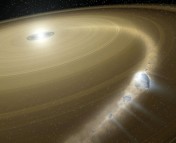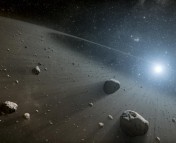- Paper Title: Dynamics of Large Fragments in the Tail of Active Asteroid P/2010 A2
- Authors: Jessica Agarwal, David Jewitt, and Harold Weaver
- First Author’s Affiliation: Max Planck Institute for Solar System Research, Germany
- Journal: The Astrophysical Journal (Accepted)
Introduction
In January 2010, the LINEAR survey make a remarkable detection: it discovered an asteroid with a long, X-shaped trail (see Figure 1). Dynamical analysis of the tail (analyzing its orbit and stability) indicated the tail had been formed in a single event around nine months prior to the January 2010 observation. This is very exciting: by studying this object, it’s possible, for the first time, get a direct observational handle on the process of asteroid disintegration! This is very important to understanding the evolution of the population of small asteroids in our solar system, as well as to understanding the formation of meteoroid streams which give rise to regular meteor showers like the Leonids. Such studies are particularly important in light of recent initiatives by private industry and NASA towards mining asteroids.
Figure 1: Hubble Space Telescope (HST) image of the active asteroid P/2010 A2. The asteroid is the dark dot on the left. The tail is the material on the right, demarcated by an X-shape. The tail seems almost detached from the asteroid, an indication (along with the dynamical analysis) that it originated in a discrete, recent event.
Method
Previous work had indicated either a collisional (something smashed into the asteroid) or rotational (the asteroid spun itself apart) origin for the tail. In this paper, the authors took many Hubble Space Telescope (HST) images of the asteroid over time, starting in January 2010, to better constrain the orbits of the tail components, and hence to get a sense of what their velocities and positions were closer to the event, with an eye to validating past work and differentiating between these scenarios.
To do this, the authors identified a number of features in the tail and tracked them from image to image (Figure 2). They assumed that the material in these features remained the same from image to image (i.e. that there was no material flow through the tail). They then conducted a suite of n-body simulations: for each region, they take a set of 10^8 particles, let their orbits evolve, and see what happens. There are four free parameters: the components of velocity (v_x, v_y, v_z) and the parameter \Beta, which measures the impact of solar radiation pressure. It’s important to note that this initial velocity refers to the velocity of the particles when they left the sphere of gravitational influence of the asteroid. The authors only have data for when the particles are moving under the Sun’s gravitational influence, and so they cannot determine orbits for when the particles were moving under the asteroid’s influence. The Hill sphere (sphere of gravitational influence) of the asteroid is about 23 km, which is sub-resolution on this HST image. The authors let the four free parameters vary and see which combination of them most closely matches the observed data.
Figure 2: HST image of the asteroid from January 2010, now showing the features in the tail selected to be tracked from image to image to determine orbital evolution.
Results and Discussion
The authors find the data to be best characterized by a February 2009 event date. The particle velocities are on the same order as the critical rotation velocity, i.e. they are similar to within an order of magnitude to how fast the asteroid would have to be rotating in order for a pebble at its surface to be at escape velocity and fly off on its own. This is consistent with both the impact and rotation cases. In the impact case, the long tail of very fast-moving particles would have escaped the field of view early on, leaving behind only slower particles. In the rotation case, no super fast particles would have been generated. Interestingly, the authors determine particle velocities that exceed the rotation velocity. This suggests that the surface of the asteroid was not just a loose pile of rubble, but was stuck together by cohesive intramolecular forces, as otherwise the material would have been flung off at a lower velocity.
The best-fit velocity vectors lie in a common plane containing the asteroid nucleus. This implies that the material was flung off from the nucleus in a common plane. This is most consistent with a rotational disintegration event, as there is no reason for the particles to have been moving in the same plane in the impact case.
Further observations of this object by other teams on other platforms provide a unique opportunity for the authors to test their models. There exist Rosetta and Keck images of this object as well, not incorporated into this study. The authors take their best-fit models and evolve them to determine synthetic images for these observations, testing how close they match: a “post-diction”, if you will. They find that overall their synthetic X’s are narrower than the observed X’s (Figure 3). This implies there is an additional diffuse component of dust parallel to the plane of the orbit not captured by the analysis. Still, however, the relatively close replication of the data is an important achievement.
Figure 3: Keck image of the asteroid (top) compared to simulated image of the asteroid (bottom). The narrower simulated image implies the existence of an additional unmodeled dust component.
The authors close by noting the importance of finding and studying an active asteroid immediately after the disintegration event. Early discovery would mean that high-velocity particles, if any, would not have had time to escape, permitting robust discrimination between the rotational and impact hypotheses.






